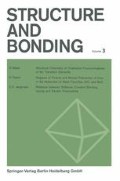Abstract
The quantity p=μ/er, introduced in 1928 in order to examine the influence of ionic deformation on the polarity of the HCl and HBr molecules, is used here as a measure of the degree of polarity of the molecules M+F−. Correspondingly, for the molecules M2+O2− the degree of polarity is p=μ/2 er. Using reliable experimental data for μ and r, it is shown that the molecule NaF has, among diatomic molecules, the highest known (0.878) degree of polarity, in confirmation of a prediction of 1925, while CsF has, among the alkali fluorides, the smallest p (0.699). Correspondingly, the isoelectronic BaO has a smaller p (0.426 vs 0.483) than SrO.
A precise quantitative theory of the mutual polarization of ions in molecules is not possible as long as one cannot take into account the inhomogeneity of the field of the polarizing ion and the dependence of the polarizability of the polarized ion on its surroundings. It is therefore attempted to correlate the observed dependence of the p values on r and the polarizability of the ions in a semi-quantitative and semi-empirical fashion. This proves to be successful for the alkali fluorides but explains only qualitatively why the degree of polarity is smaller for BaO than for SrO.
Preview
Unable to display preview. Download preview PDF.
References
Fajans, K.: Z. Kristall. 61, 42 (1925).
See, e.g., Coulson, C. A.: Valence, 2nd ed., p. 138. Oxford: Clarendon Press 1961.
Honig, A., M. Mandel, M. L. Stitch, and C. H. Townes: Phys. Rev. 96, 629 (1954); see also Trischka, J. W.: ibid. Phys. Rev. 76, 1365 (1949).
Bauer, R. K., and H. Lew: Canad. J. Phys. 41, 1461 (1963).
Fajans, K.: Z. Elektrochem. 34, 502 (1928).
Pauling, L.: J. Am. Chem. Soc. 54, 988 (1932).
Pauling, L.: The Nature of the Chemical Bond, 1st ed. 1939, p. 44–46; 3rd ed. 1960, p. 76. Ithaca, New York: Cornell University Press.
Kaufmann, M., L. Wharton, and W. Klemperer: J. Chem. Phys. 43, 943 (1965).
Fajans, K.: Naturwiss. 11, 165 (1923).
Fajans, K.: Z. Kristallogr. 61, 18 (1925). See also Ref. 11, p. 65.
See also Fajans, K.: Radioelements and Isotopes. Chemical Forces and Optical Properties of Substances, p. 86. New York: McGraw-Hill Book Co 1931.
Hughes, H. K.: Phys. Rev. 72, 614 (1947).
Fajans, K.: Ceramic Age 54, 292 (1949).
Fajans, K.: The Encyclopedia of Chemistry, p. 763. Editors G. L. Clark and G. G. Hawley. New York: Reinhold Publishing Corporation 1957. In this article the symbol p was introduced for the degree of polarity.
Born, M., and W. Heisenberg: Z. Physik 23, 388 (1924).
Rittner, E. S.: J. Chem. Phys. 19, 1030 (1951).
Pauling, L.: Proc. Roy. Soc. 114 A, 191 (1927). Sec comments on this derivation by K. Fajans: Z. physik. Chem. 24 B, 130 (1934).
Originally derived by K. Fajans and G. Joos, Z. Physik 23, 1 (1924), as molar refractivity, R, of gaseous ions for the D-line, revised by K. Fajans, Ref. 18, Z. physik. Chem. 24 B, 130 (1934), p. 118 and extrapolated to infinite wave lengths by N. Bauer and K. Fajns, J. Am. Chem. Soc. 64, 3031 (1942). The a values in Å3 were obtained from the R values in cm3 dividing by 2.522. The latter applies also to the L. P. values.
Tessman, J. R., A. H. Kahn, and W. Shockley: Phys. Rev. 92, 890 (1953).
Jørgensen, C. K.: Structure and Bonding 1, 236 (1966).
Fajans, K.: in: Physical Methods of Organic Chemistry. Editor A. Weissberger, 3rd ed., Vol. I, Part II pp. 1169–1211. New York: Interscience Publishers 1960.
Analogous effects in alkali halide crystals were analysed in Ref. 24; see also Ruffa, A. R.: Phys. Rev. 130, 1419 (1963).
Fajans, K.: Z. physik. Chem, 130, 724 (1927).
Using the R ∞ values for X− and HX from the paper with Bauer Ref. 19 and r e valeus, Eq (7) results: ΔR a=−C α a 2/r 3. The dimensionless C is for: HCl 1536, HBr. 1579. III. 1580. The r e are, as some other spectroscopic data, from G. Herzberg’s Spectra of Diatomic Molecules, 2nd ed. New York: D. Van Nostrand Inc. 1950.
This might be due to the “radiusratio-effect” emphasized by Pauling Ref. 7,. p. 529 in the 1960 edition).
See Fajans, K.: Chimia 13, 349 (1959). Lithoprinted English translation at Ulrich’s Book Store, Ann Arbor, Michigan.
See such an examination for the monohydrides by K. Fajans: J. Chem. Phys. 43, 2159 (1965).
Barrow, R. F., and A. D. Caunt: Proc. Roy. Soc. 219A, 120 (1953), Table 13, column 1.
Fajans, K., and N. Bauer: J. Chem. Phys. 10, 410 (1942).
Mulliken, R. S.: Phys. Rev. 50, 1017 (1936).
Wall, F. T.: J. Am. Chem. Soc. 61, 1051 (1939).
The value 91% is obviously estimated from Pauling’s electronegativities for F and Cs. Pauling (Ref. 7, 1960, p. 530) gives on the same basis 94%.
Yoshimine, M.: J. Chem. Phys. 40, 2970 (1964).
Wharton, L., M. Kaufman, and W. Klemperer: J. Chem. Phys. 37, 624 (1962).
Pauling, L.: (Ref. 7,, 2nd ed. 1940, p. 74, and 3rd ed., 1960, p. 102) gives for the Be−O bond an ionic character of 63%, i.e., about half of the above value.
Mulliken, R. S.: J. Chem. Phys. 43, S2 (1965).
Fajans, K.: J. Physic. and Coll. Chem. 55, 1107 (1951).
Fajans, K.: Chem. & Eng. News 43, issue of May 31, 1965, p. 96.
Author information
Authors and Affiliations
Editor information
Rights and permissions
Copyright information
© 1967 Springer-Verlag
About this paper
Cite this paper
Fajans, K. (1967). Degrees of polarity and mutual polarization of ions in the molecules of alkali fluorides, SrO, and BaO. In: Jørgensen, C.K., Neilands, J.B., Nyholm, R.S., Reinen, D., Williams, R.J.P. (eds) Structure and Bonding. Structure and Bonding, vol 3. Springer, Berlin, Heidelberg. https://doi.org/10.1007/BFb0118879
Download citation
DOI: https://doi.org/10.1007/BFb0118879
Received:
Published:
Publisher Name: Springer, Berlin, Heidelberg
Print ISBN: 978-3-540-03990-7
Online ISBN: 978-3-540-35560-1
eBook Packages: Springer Book Archive

